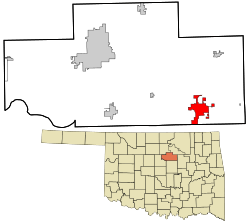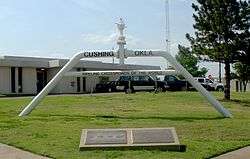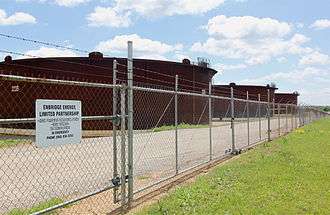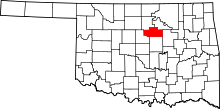Cushing, Oklahoma
| Cushing, Oklahoma | |
|---|---|
| City | |
|
Pipeline Crossroads of the World monument (2006) | |
| Nickname(s): "Pipeline Crossroads of the World" | |
| Motto: "Personal Connections. Global Impact." | |
 Location within Payne County and Oklahoma | |
| Coordinates: 35°58′57″N 96°45′51″W / 35.98250°N 96.76417°WCoordinates: 35°58′57″N 96°45′51″W / 35.98250°N 96.76417°W | |
| Country | United States |
| State | Oklahoma |
| County | Payne |
| Area | |
| • Total | 7.6 sq mi (19.8 km2) |
| • Land | 7.6 sq mi (19.8 km2) |
| • Water | 0.0 sq mi (0.0 km2) |
| Elevation | 935 ft (285 m) |
| Population (2010) | |
| • Total | 7,826 |
| • Estimate (2013)[1] | 7,889 |
| • Density | 1,000/sq mi (400/km2) |
| Time zone | Central (CST) (UTC-6) |
| • Summer (DST) | CDT (UTC-5) |
| ZIP code | 74023 |
| Area code | 539/918 |
| FIPS code | 40-18850 [2] |
| GNIS feature ID | 1091897 [3] |
| Website | City Website |
Cushing is a city in Payne County, Oklahoma, United States. The population was 7,826 at the 2010 census, a decline of 6.5 percent from 8,371 at the 2000 census.[4]
The city was established after the Land Run of 1891 by William "Billy Rae" Little. It was named for Marshall Cushing, private secretary to U.S. Postmaster General John Wanamaker. An oil boom that began in 1912 led to the city's development as a refining center.[5]
Today, Cushing is a major trading hub for crude oil and a famous price settlement point for West Texas Intermediate on the New York Mercantile Exchange.[6]
History
The area that would become Cushing was part of the Sac and Fox Reservation. With the Land Run of 1891, a former government trader for the tribe, Billy Rae Little, built a house, established his claim, and laid out town lots. The town got a post office on November 10, 1891 and was named for Marshall Cushing, private secretary to U.S. Postmaster General John Wanamaker.[5]
In 1902, the Eastern Oklahoma Railway line to Cushing was built. The Missouri, Kansas and Texas Railway added service on its own line built in 1903.[5]
Wildcatter Thomas B. Slick started an oil boom on March 17, 1912 when he brought in a gusher east of the town. Other wells were soon drilled nearby, and the oil field became known as the Cushing-Drumright Oil Field. The city became a center for exploration of and production from nearby oil fields and also a refining center, when Consumers Oil Company opened a refinery in 1913. Production centered on the new town of Drumright, and Cushing became a refining center. Eventually, 23 oil companies and five oil-field supply houses located in the town,[5]and more than 50 refineries once operated in the Cushing area.[7] Pipelines and storage facilities have since made it “the pipeline crossroads of the world.
The oil boom did not last long. Annual production peaked in 1915 with 8.3 million barrels of oil, but production declined by fifty percent in 1916.
During the 1970s and 1980s refining operations continued in Cushing until the last two refineries, Kerr-McGee and Hudson, closed. Rail service ended in 1982.[5] As the oil fields started to run dry, starting in the 1940s, production and refining became less important.
However the town retained a great asset in the Shell pipeline terminal, with thirty-nine storage tanks and pipelines that could move as much as 1.5 million barrels a day. This enhanced Cushing's status as "Pipeline Crossroads of the World."
The maze of pipelines and tanks that had been built led to the NYMEX choosing Cushing as the official delivery point for its light sweet crude futures contract in 1983.
Geography
Cushing is located in Payne County, Oklahoma at the intersection of state highways 33 and 18. Its geographic coordinates are 35°58′57″N 96°45′51″W / 35.98250°N 96.76417°W (35.982628, -96.764171).[8] According to the United States Census Bureau, the city has a total area of 7.6 square miles (20 km2), of which, 7.6 square miles (20 km2) is land and 0.13% is water.
Climate
| Climate data for Cushing, Oklahoma | |||||||||||||
|---|---|---|---|---|---|---|---|---|---|---|---|---|---|
| Month | Jan | Feb | Mar | Apr | May | Jun | Jul | Aug | Sep | Oct | Nov | Dec | Year |
| Record high °F (°C) | 81 (27) |
83 (28) |
92 (33) |
101 (38) |
100 (38) |
108 (42) |
117 (47) |
112 (44) |
110 (43) |
99 (37) |
85 (29) |
82 (28) |
117 (47) |
| Average high °F (°C) | 48 (9) |
54 (12) |
61 (16) |
73 (23) |
80 (27) |
89 (32) |
94 (34) |
95 (35) |
88 (31) |
76 (24) |
62 (17) |
52 (11) |
72.7 (22.6) |
| Average low °F (°C) | 25 (−4) |
30 (−1) |
36 (2) |
49 (9) |
59 (15) |
67 (19) |
71 (22) |
70 (21) |
61 (16) |
51 (11) |
37 (3) |
29 (−2) |
48.8 (9.3) |
| Record low °F (°C) | −11 (−24) |
3 (−16) |
−2 (−19) |
23 (−5) |
32 (0) |
45 (7) |
55 (13) |
51 (11) |
35 (2) |
24 (−4) |
10 (−12) |
−1 (−18) |
−11 (−24) |
| Average precipitation inches (mm) | 1.3 (33) |
1.6 (41) |
2.1 (53) |
3.5 (89) |
5.8 (147) |
5.1 (130) |
4.3 (109) |
2.7 (69) |
3.7 (94) |
3 (80) |
1.6 (41) |
1.3 (33) |
35.8 (909) |
| Average snowfall inches (cm) | 3.6 (9.1) |
2.1 (5.3) |
1.3 (3.3) |
0.1 (0.3) |
— | — | — | — | — | — | 0.3 (0.8) |
1.4 (3.6) |
8.8 (22.4) |
| Average rainy days | 3.3 | 3.9 | 5 | 6.5 | 7.4 | 7.8 | 7.1 | 5.2 | 5.9 | 5 | 3.1 | 3.3 | 63.5 |
| Average relative humidity (%) | 70 | 68 | 63 | 62 | 70 | 69 | 66 | 64 | 63 | 63 | 61 | 66 | 65 |
| Source #1: weather.com | |||||||||||||
| Source #2: Weatherbase.com [9] | |||||||||||||
Demographics
| Historical population | |||
|---|---|---|---|
| Census | Pop. | %± | |
| 1900 | 226 | — | |
| 1910 | 1,072 | 374.3% | |
| 1920 | 6,326 | 490.1% | |
| 1930 | 9,301 | 47.0% | |
| 1940 | 7,703 | −17.2% | |
| 1950 | 8,414 | 9.2% | |
| 1960 | 8,619 | 2.4% | |
| 1970 | 7,529 | −12.6% | |
| 1980 | 7,720 | 2.5% | |
| 1990 | 7,218 | −6.5% | |
| 2000 | 8,371 | 16.0% | |
| 2010 | 7,826 | −6.5% | |
| Est. 2015 | 7,867 | [10] | 0.5% |
| U.S. Decennial Census | |||
As of the census[2] of 2000, there were 8,371 people, 3,071 households, and 2,002 families residing in the city. The population density was 1,096.1 people per square mile (423.0/km²). There were 3,636 housing units at an average density of 476.1 per square mile (183.8/km²). The racial makeup of the city was 79.66% White, 7.02% African American, 7.97% Native American, 0.13% Asian, 0.90% from other races, and 4.32% from two or more races. Hispanic or Latino of any race were 2.70% of the population.
There were 3,071 households out of which 29.9% had children under the age of 18 living with them, 48.7% were married couples living together, 12.4% had a female householder with no husband present, and 34.8% were non-families. 31.3% of all households were made up of individuals and 16.1% had someone living alone who was 65 years of age or older. The average household size was 2.39 and the average family size was 2.99.
In the city the population was spread out with 22.9% under the age of 18, 10.0% from 18 to 24, 29.5% from 25 to 44, 20.0% from 45 to 64, and 17.6% who were 65 years of age or older. The median age was 37 years. For every 100 females there were 111.4 males. For every 100 females age 18 and over, there were 115.6 males.
The median income for a household in the city was $26,483, and the median income for a family was $32,284. Males had a median income of $26,710 versus $17,711 for females. The per capita income for the city was $12,620. About 15.1% of families and 16.4% of the population were below the poverty line, including 21.0% of those under age 18 and 10.1% of those age 65 or over.
Oil industry
Operators

Cushing is a "vital transshipment point with many intersecting pipelines, storage facilities and easy access to refiners and suppliers." Crude oil flows "inbound to Cushing from all directions and outbound through dozens of pipelines."[11] In 2005, crude oil and refined products in the U.S. were almost always transported by interconnected pipeline systems. In Oklahoma, eight private companies operated almost all the pipelines and frequently operated oil terminals and refineries: Enbridge; Enterprise Products; Explorer Pipeline; Jayhawk; Magellan Midstream Partners; Plains All American Pipeline; Sunoco; and Valero Energy.[12]
There is approximately 85 million barrels of crude oil storage tanks around Cushing.[13][14] On October 28, 2016, tanks held a total of 58.5 milion barrels of oil.[15]
A partial list of tank farm owners at Cushing are:[16]
- Magellan Midstream Partners, 7,800,000 barrels (1,240,000 m3) of storage, formerly owned by BP.
- Enbridge Energy Partners, 20,060,000 barrels (3,189,000 m3) of storage.
- Enterprise Products, 3,100,000 barrels (490,000 m3) of storage.
- JP Energy, 3,000,000 barrels (480,000 m3) of storage.
- Plains All American Pipeline, 20,000,000 barrels (3,200,000 m3) of storage.
- SemGroup, 7,600,000 barrels (1,210,000 m3) of storage at Rose Rock Midstream Cushing terminal.
A partial list of pipelines with connections at Cushing are:[17]
- Basin Oil Pipeline, operated by Plains All American Pipeline, flows from Wichita Falls, Texas connecting various fields in Texas.
- Centurion Pipeline, flows from Permian Basin fields in west Texas and southeast New Mexico.
- Hawthorn Pipeline, operated by Hawthorn Oil Transportation, a 17-mile pipeline from Stroud, Oklahoma where a rail unloading facility receives oil from Stanley, North Dakota for EOG Resources.[18][19][20]
- Glass Mountain Pipeline, operated by Rose Rock Midstream (SemGroup), flows from fields in west and north-central Oklahoma.
- Great Salt Plains Pipeline, operated by JP Energy, flows from fields around Cherokee, Oklahoma, formerly owned by Parnon Gathering.[21][22]
- Keystone Pipeline, operated by TransCanada, flows from Hardisty, Alberta (Canada) to an intermediatery hub in Cushing to Port Arthur, Texas. It has a maximum capacity of 590,000 barrels per day (94,000 m3/d). Another Keystone termination is located at the oil tank farm near Patoka, Illinois.[23][24]
- Mississippian Lime Pipeline, operated by Plains All American Pipeline, flows from fields in northern Oklahoma and southern Kansas.
- PAA Medford Pipeline, operated by Plains All American Pipeline, from fields around Medford, Oklahoma.
- Pony Express Pipeline, operated by Tallgrass Energy Partners, flows from fields around Guernsey, Wyoming. It connects to the Ponca City Refinery. It has a capacity of 230,000 barrels per day (37,000 m3/d) and capable of increasing to 400,000 barrels per day (64,000 m3/d).
- Seaway Pipeline, operated by Enbridge and Enterprise Products, dual pipeline flows out to Freeport, Texas. It has a maximum capacity of 850,000 barrels per day (135,000 m3/d).
- SemCrude Pipeline System, operated by Rose Rock Midstream (SemGroup), flows from fields in Kansas and northern Oklahoma.
- Spearhead Pipelines, operated by Enbridge, is a pipelines that flows from the Enbridge Mainline System near Flanagan, Illinois. It has a maximum capacity of 125,000 barrels per day (19,900 m3/d).[25] A second pipeline, Flanagan South, parallels the Spearhead. A third Enbridge pipeline connects to the Wood River Refinery in Roxana, Illinois.[26]
- White Cliffs Pipeline, operated by Rose Rock Midstream, flows from fields around Platteville, Colorado.
Transhipment point for West Texas Intermediate (WTI) oil
Cushing is the delivery point for West Texas Intermediate, a blend of US light sweet crude oil streams.[11] traded on the New York Mercantile Exchange[27]
Cushing's strategic position as a major hub in oil supply led to WTI’s development as a significant physical market price reference or benchmark for over three decades.
In 2005 Cushing was described [28] as the most significant trading hub for crude oil in North America, connecting the Gulf Coast suppliers with northern consumers.
In 2006, with production increases from Canadian oil sands, one pipeline reversed direction, bringing crude into the Cushing Hub, rather than delivering crude from Cushing to oil refineries.
By 2007 Cushing held 5 to 10 percent of the total U.S. crude inventory. Signs made of a pipe and valve on the major highways near town proclaim Cushing to be the "Pipeline Crossroads of the World", and the town is surrounded by several tank farms.
Oil futures designated delivery point in the US
On April 13, 2007, the now-defunct Lehman Brothers released a study which claimed that West Texas Intermediate (WTI) Crude at Cushing is no longer an accurate gauge of world oil prices.[29] By May 2007, Cushing's inventory fell by nearly 35% as the oil-storage trade heated up.[30]
Oil giant BP, and energy-transport and logistics firms Enbridge Energy Partners (an affiliate of Canada's Enbridge), Plains All American Pipeline and SemGroup owned most of the oil storage tanks in Cushing in October 2007.[30]
Oil storage became big business in 2008 and 2009, when the supply glut in the oil market led to situation where oil futures were higher priced than their spot price.[31] Many participants—including Wall Street giants, such as Morgan Stanley, Goldman Sachs, and Citicorp—turned sizeable profits simply by sitting on tanks of oil.[30] Institutional investors bet on the future of oil prices through a financial instrument known as oil futures, in which investors contractually agree to buy or sell oil at a set date in the future. Investors can choose to take profits or losses prior to the oil-delivery date. Alternatively, they can leave the contract in place and take physical delivery of the oil at an "officially designated delivery point" in the United States; this delivery point is usually Cushing.
On July 13, 2010, BP announced it will sell its assets in Cushing to Magellan Midstream Partners.[32]
Cushing storage hub bottleneck
The bottleneck at Cushing's giant storage hub distorted benchmark U.S. oil prices for many years. In 2007 a large stockpile of oil at the facility was caused largely because Valero Energy Corp.'s McKee refinery near Sunray, Texas, was shut down.[33] With the refinery closed, crude oil prices were artificially depressed at the Cushing pricing point. The Eagle North pipeline reactivated in 2010, added offtake capacity to Cushing by connecting Valero's oil refinery in Ardmore, Oklahoma with Cushing's cheap crude oil. This should have resulted in boosting WTI prices which were discounted against Brent crude oil because of the glut.[34]
In March 2013 Valero Energy Corp.'s (VLO) McKee refinery in Sunray, Texas was closed for five weeks for planned maintenance.[35]
Oil industry and seismic activity
In October 2014 two moderate-sized earthquakes (Mw 4.0 and 4.3) struck south of Cushing, below one of the largest crude oil storage facility and gas pipeline transportation in the world. The system also includes operational sections of the Keystone pipeline.[36]
On 6 November 2016, around 7:44 pm, a 5.0 Mw earthquake rattled north-central Oklahoma. The quake was centered one mile west of Cushing.[15] It was the sixth 5.0 magnitude or higher to strike the state since 1882. Three of those larger quakes occurred in 2016, and the strongest ever recorded in Oklahoma was a 5.8 magnitude that hit Pawnee (25 miles from Cushing) in September.[37]
According to George Choy, a geophysicist with the U.S. Geological Survey, Oklahoma has had a severe spike in earthquakes of 3.0 magnitude or higher since 2008, when energy companies ramped up their hydraulic fracturing for oil and gas in the state. The number of 3.0 magnitude quakes rose from 2 in 2008 to 889 in 2015, according to USGS statistics. In 2016, there have been 572 (up to November). "The oil companies have said for a long time that these are natural earthquakes, that they would have occurred anyway," Choy said, "but when you look at the statistics, that argument does not fly."[37]
Analysis of the spatial distribution of earthquakes and regional moment tensor focal mechanisms indicated reactivation of a subsurface unmapped strike-slip fault . [36]The discovery stoked fears among scientists about other unknown faults that could be triggered by oil and gas wastewater being injected deep underground. [38] Coulomb failure stress change calculations indicated that the Wilzetta Fault zone south of Cushing could produce a large, damaging earthquake comparable to the 2011 Prague event.[36]
Wastewater collected during fracking is later disposed of by injecting it into deep underground wells at high pressure. That water fills pores in dormant faults, causing them to slip and unleash the quakes. After the strongest earthquake in the state's history, concerns about the relationship between disposal wells and earthquakes made state and federal regulators shut down more than 50 disposal sites and wells across Oklahoma in 2016 considering they were too near the newly discovered fault line.[37][38]
Government
Cushing has a commissioner-manager form of government.[5]
Education
The Cushing school district has five schools that include a preschool, two elementary schools, a middle school, and a high school. The district serves approximately 1,800 students.[39]
- Cushing High School
- Cushing Middle School (5th-8th)
- Cushing Upper Elementary (2nd-4th)
- Lower Elementary School (K-1st)
- Sunnyside Elementary School (Pre-K)
Notable people
- Paul Blair, professional baseball player[40]
- Al Buell, former painter of pin-up art
- Kelly Cook, former running back in the National Football League[41]
- Sam Harris, Actor, Singer, Songwriter
- Chief Hogsett, former pitcher in Major League Baseball
- Brian Kelly, professional boxer
- Bob Shirley, former professional baseball pitcher
See also
References
- ↑ "Population Estimates". United States Census Bureau. Retrieved 2015-03-07.
- 1 2 "American FactFinder". United States Census Bureau. Archived from the original on 2013-09-11. Retrieved 2008-01-31.
- ↑ "US Board on Geographic Names". United States Geological Survey. 2007-10-25. Retrieved 2008-01-31.
- ↑ CensusViewer:Population of the City of Cushing, Oklahoma
- 1 2 3 4 5 6 Encyclopedia of Oklahoma History and Culture."Cushing". By D. Earl Newsome, Accessed June 9, 2010.
- ↑ "Crude Oil Futures Contract Specs. Delivery.".
- ↑ Oklahoma Oil History. American Oil & Gas Historical Society
- ↑ "US Gazetteer files: 2010, 2000, and 1990". United States Census Bureau. 2011-02-12. Retrieved 2011-04-23.
- ↑ "Historical Weather for Cushing, Oklahoma, United States".
- ↑ "Annual Estimates of the Resident Population for Incorporated Places: April 1, 2010 to July 1, 2015". Retrieved July 2, 2016.
- 1 2 "Light Sweet Crude Oil (WTI) Futures and Options: When the World Asks, "What's the Price of Crude Oil?" WTI is the Answer" (PDF). CME Group.
- ↑ Smoot, D.E. (28 August 2016). "Company prepares to construct pipeline through Muskogee, McIntosh counties". Muskogee Phoenix. Retrieved 28 August 2016.
- ↑ Oil tanker demand booms as traders wait out cheap oil; cbc.ca; January 14, 2015.
- ↑ US running out of room to store oil; price collapse next?; AP; March 3, 2015.
- 1 2 Extensive damage reported from Oklahoma earthquake near major oil hub; CBS News; November 7, 2016.
- ↑ Inside the World’s Biggest Tank Farm in Cushing; Tank World Blog; January 30, 2014.
- ↑ U.S. crude oil pipeline project; Yahoo Finance / Reuters; April 6, 2015.
- ↑ Company history; EOG Resources.
- ↑ First train with EOG Resources Bakken crude oil departs Stanley, ND for Oklahoma; EOG Resources. North Dakota Petroleum Council, December 31, 2009.
- ↑ Crude Oil Offload Terminal; JFSCO Engineering.
- ↑ Great Salt Plains Pipeline; IPS Engineering.
- ↑ JP Energy Partners acquires Parnon Storage and Paronon Gathering; Business Wire; August 14, 2012.
- ↑ Ken Newton (June 9, 2010). "Oil Flows Through Keystone". St. Joseph, Missouri: St. Joseph News-Press.
- ↑ Press Release – Keystone Pipeline Starts Deliveries to U.S. Midwest; TransCanada; June 30, 2010.
- ↑ "Liquids Pipelines". Enbridge. Retrieved 2012-02-08.
- ↑ EIA Short-Term Look At Crude Oil Pipeline Infrastructure; Pipeline & Gas Journal; April 2013.
- ↑ U.S. Energy Information Administration (EIA). "Upcoming Pipeline Capacity Additions Will Facilitate Continued Growth in Crude Oil Shipments from Midwest to Gulf Coast" (PDF). This Week in Petroleum. CME Group.
- ↑ The 2005 Oklahoma Refinery Report: Appendix A (PDF) (Report). Oklahoma: Office of the Secretary of Energy. April 2005.
- ↑ Margot Habiby (2007-04-13). "WTI Prices Don't Reflect International Oil Market, Study Says". Bloomberg.
- 1 2 3 Davis, Anne (6 October 2007). "Where Has All The Oil Gone? After Sitting on Crude, Speculators Unload It. The World's Eyes Fall on Cushing, Oklahoma". Wall Street Journal.
- ↑ Norris, Michele (17 December 2008). "Contango In Oil Markets Explained".
- ↑ "Magellan snaps up BP midstream package". Upstream Online. NHST Media Group. 2010-07-13. Retrieved 2010-07-13.
- ↑ Mark Shenk (2007-04-13). "Crude Oil in New York Falls on Increasing Supplies in Oklahoma". Bloomberg.
- ↑ Campbell, Robert (5 October 2010). "Valero oil refinery to link to Cushing hub soon". New York: Reuters.
- ↑ "Refinery Status: Citgo Reports Leak at Corpus Christi - WSJ.com". Wall Street Journal. 4 Apr 2013.
- 1 2 3 McNamara, D. E. et al. (2015),Reactivated faulting near Cushing, Oklahoma: Increased potential for a triggered earthquake in an area of United States strategic infrastructure, Geophysical Research Letters, 42, 8328–8332, doi:10.1002/2015GL064669.
- 1 2 3 Oklahoma earthquake reignites concerns that fracking wells may be the cause. By Rick Jervis. USA TODAY, November 7, 2016.
- 1 2 New fault line discovered after 5.8 Oklahoma earthquake. By Sean Murphy. Associated Press/ The Wichita Eagle, September 13, 2016
- ↑ Cushing School District, Education.com (accessed June 9, 2010).
- ↑ News services and staff reports (December 28, 2013) "Star center fielder won two titles with Orioles" The Washington Post, page B4. Retrieved December 28, 2013
- ↑ "Kelly Cook". databaseFootball.com. Retrieved December 15, 2012.
External links
| Wikimedia Commons has media related to Cushing, Oklahoma. |
- City of Cushing
- Cushing Chamber of Commerce
- Cushing Citizen Online
- Encyclopedia of Oklahoma History and Culture - "Cushing"
- Cushing Public Schools
- Cushing in 2009, ABC TV


